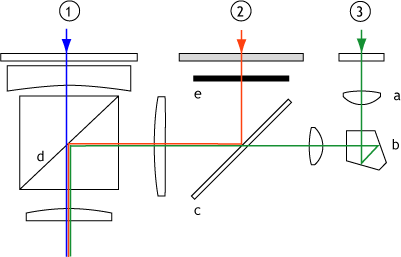CameraQuest Home Camera Articles FOR SALE Orders I Buy / Wants Repairs Books Adapters
Epson R-D1: Rangefinder accuracy
How a rangefinder works
A rangefinder focuses by triangulation. On the front of the Epson R-D1 are three windows, and images from two of them (windows 1 and 3 in Figure 1) are seen simultaneously in the viewfinder; the lens is focused when the two images are superimposed exactly.

Figure 1. Simplified diagram of the Epson R-D1 rangefinder mechanism. Window 1 is the main viewfinder. Window 2 is frosted, and provides illumination for the frameline masks (e), which are reflected into the main viewfinder. Window 3 is the rangefinder patch.
The beam from window 3 passes through a lens (a) that pivots to shift and focus the image as the camera-lens focusing ring is turned. The beam is then reflected 90° by a prism and mirror (b), passes through a semi-silvered mirror (c; needed to reflect the frameline image into the main viewfinder), and is again reflected by another semi-silvered mirror (d) into the main viewfinder path.
The focusing accuracy of a rangefinder is dependent on a number of factors, one of which is the separation between windows 1 and 3 in Figure 1: the base length. The longer the base length, the more accurately the camera can focus. The Epson R-D1 has a moderately short base length of 38.2 mm, the same as its film cousin, the Voigtländer Bessa R3. Most Leica M series cameras have a base length of 49 mm. Other factors are the aperture and focal length of a lens: as the aperture increases, the depth of field becomes shallower; and as the focal length increases, the depth of field for a given aperture decreases. The shallower the depth of field, the more important the focusing error becomes.
For a given base length there is a maximum aperture above which focusing becomes erratic owing to the increased dominance of the focusing error. Base length and aperture are related by the equation
a = ef 2/bc
where a is the maximum aperture, e is visual acuity (a measure of our ability to resolve fine detail), f is the focal length of the lens, b is the rangefinder base length and c is the circle of confusion (which dictates the limits of focus, i.e. the depth of field).
Focal lengths and maximum apertures for the Epson R-D1
Taking b = 38.2 mm, c = 0.02 mm and e = 0.0003 gives the maximum apertures listed in Table 1 (apertures given as the closest half-stop). As can be seen, focusing a 135 mm lens wide open and close to the subject may prove challenging on the R-D1. For comparison, the maximum aperture for a 135 mm lens on a Leica M7 (0.72 viewfinder) is f/3.5, to the nearest half-stop: the latter’s base length is longer, and the image is larger (depth of field is less critical, so c = 0.03 mm).
Table 1. Epson R-D1: widest apertures for accurate focusing
| Focal length | Maximum aperture | |
| 50 mm | f/1.0 | |
| 75 mm | f/2.2 | |
| 90 mm | f/3.2 | |
| 135 mm | f/7.2 | |
There is one way in which focusing accuracy can be improved on the R-D1: fitting a viewfinder magnifier. The Megaperls ×1.3 viewfinder magnifier increases the R-D1’s effective base length to 49.7 mm, which increases the maximum aperture by about a stop (e.g. f/2.4 for 90 mm).
Backlash
Rangefinders can suffer from ‘backlash’: slack in the focusing mechanism (of the camera or the lens) resulting in the point of focus being different depending on which direction the lens focusing ring is turned to reach focus. There are reports of minor backlash in the Epson R-D1 – but this is an uncommon fault.
Backlash should be absent, but, if present, it can affect focusing at wide apertures close to the rangefinder’s limit. The solution – which is good practice when using any rangefinder, not just the R-D1 – is not to rack the lens back and forth incrementally about the focus point the way one does when using an SLR. Instead, start at one end of the focusing scale, turn the focusing ring slowly and then stop when the coincident images align. If you overshoot, turn the focusing ring back and start again.
Experiment to see whether turning the focusing ring clockwise or anticlockwise to reach focus makes any difference to the accuracy of focus. If it does, always turn the focusing ring in that direction to reach focus.
It is important not to overstate the importance of backlash: inaccurate focusing may simply result from the focal length or aperture of the lens exceeding the limits of accuracy of the rangefinder, as discussed; for example, the Leica 135 mm f/2.8 cannot be focused reliably below f/5.6.
 Rangefinder accuracy
Rangefinder accuracy